When you pick up a prescription, you might not think twice about whether it’s the brand name or the generic version. After all, the FDA says they’re the same. But if you’ve been on a medication for years - say, for high blood pressure, epilepsy, or thyroid disease - you might wonder: is the generic really just as safe over the long haul?
What Does ‘Therapeutic Equivalence’ Really Mean?
The FDA requires generics to match brand-name drugs in active ingredient, strength, dosage form, and route of administration. They also must prove bioequivalence: the amount of drug absorbed into your bloodstream must fall within 80% to 125% of the brand’s levels. That sounds tight. But here’s the catch - that’s a 45% range. For most drugs, that’s fine. For others, it’s a big deal. Take levothyroxine, the go-to treatment for hypothyroidism. A 2017 study found that patients switching from Synthroid to generic versions had 12.3% more fluctuations in their TSH levels. That might not sound like much, but for someone whose thyroid hormone balance is razor-thin, even a small shift can mean fatigue, weight gain, or heart rhythm problems. The same goes for warfarin, an anticoagulant where tiny differences in blood levels can lead to dangerous clots or bleeding. The FDA’s standards were designed for simple, oral pills. They weren’t built for complex drugs - like inhalers, long-acting injections, or topical creams - where delivery matters as much as the ingredient. In 2022, the FDA updated its guidance to address these gaps. But many of the generics on shelves today were approved years ago under older rules.Big Studies Show Generics Can Be Safer
Here’s where things get surprising. A massive 2020 study in Scientific Reports looked at over 1.5 million Austrians on chronic medications between 2007 and 2012. They tracked people taking either brand or generic versions of antihypertensives, statins, and diabetes drugs. The results? Generics were linked to fewer deaths and heart events. For blood pressure meds specifically:- Branded users: 53.8 deaths per 1,000 patient-years
- Generic users: 30.2 deaths per 1,000 patient-years
The Manufacturing Factor: Where Your Drug Comes From Matters More Than Brand
A 2018 study from Ohio State University dug into the FDA’s adverse event database and found something startling: the country of manufacture mattered more than brand vs generic. Generic drugs made in India had 54% higher rates of severe adverse events - including hospitalizations and deaths - compared to the same drugs made in the U.S. For ciprofloxacin, the risk jumped 62% for the Indian-made version. That’s not about the generic label. That’s about quality control, raw materials, and inspection standards. This isn’t about blaming one country. It’s about recognizing that not all generics are created equal. The same company that makes a brand-name drug can also make a generic version - called an authorized generic. These often perform just as well as the brand. But they’re not labeled as such, so most patients don’t know they’re getting the same product.
When Switching Causes Real Problems
Not every case is about population data. Sometimes, it’s about one person. A 2013 case study in the PMC journal described two patients who switched from brand to generic antibiotics - ciprofloxacin and levofloxacin - and got worse. Symptoms didn’t improve. Fever stayed high. Only when they switched back to the brand did they recover. One patient had been taking the generic for weeks before realizing something was off. Another case, shared on Reddit in 2023, involved a patient with epilepsy who went from 1-2 seizures a month on brand Lamictal to 8-10 on generic lamotrigine. After switching back, the seizures vanished. That’s not rare. In fact, a 2022 analysis of 3,842 patients on PatientsLikeMe found that 12.6% reported worse effectiveness with generics - and 9% actually felt better. These aren’t flukes. They’re signals. For drugs with a narrow therapeutic index - where the difference between effective and toxic is small - even minor changes in absorption or inactive ingredients can trigger reactions.Adverse Event Reports: Are Generics Riskier?
The FDA’s database (FAERS) shows 1,247 reports between 2018 and 2022 saying a generic drug was “ineffective.” Only 289 said the same about brand-name drugs. At first glance, that looks bad for generics. But here’s the real story: generics make up 92% of all prescriptions in the U.S. Brands make up just 8%. So if you’re seeing 4 times as many reports for generics, you’re actually seeing fewer reports per prescription. The rate of complaints is lower for generics - even with far more users. Still, the pattern is telling. For amlodipine (a blood pressure drug), 56% of adverse reports came from generic versions, while only 29.5% came from the brand. But when the same company made a generic version of the same drug (an authorized generic), the report rate dropped to 14%. That suggests the problem isn’t the generic label - it’s the manufacturer.What the Experts Really Say
The FDA, the American Medical Association, and most public health groups still say generics are safe and equivalent. And for the vast majority of drugs - antibiotics, statins, antidepressants - they’re right. But Dr. Aaron Kesselheim from Harvard Medical School, who’s studied this for over a decade, puts it plainly: “For some drugs, the difference isn’t theoretical. It’s life-changing.” He points to levothyroxine, warfarin, phenytoin, and cyclosporine as high-risk categories where switching can cause real harm. The bottom line? Most generics are fine. But not all. And the risk isn’t evenly distributed.
What You Should Do
If you’re on a long-term medication, here’s how to protect yourself:- Know your drug’s therapeutic index. If it’s for thyroid, epilepsy, heart rhythm, or blood thinning - tread carefully. Ask your pharmacist or doctor if yours is a narrow-index drug.
- Don’t switch without talking to your provider. If you’re stable on a brand, don’t let a pharmacy substitute it without your consent. You have the right to request the brand.
- Check the manufacturer. Look at the name on the bottle. If it’s the same as the brand (e.g., “Bayer” making a generic version), that’s an authorized generic - likely your safest bet.
- Track your symptoms. If you feel worse after a switch - fatigue, dizziness, seizures, unusual bruising - don’t assume it’s “just your condition.” Document it and go back to your doctor.
- Ask for the brand if cost isn’t a barrier. If you’re paying out of pocket or have good insurance, the small extra cost might be worth the peace of mind.


Conor McNamara
November 17, 2025 AT 12:53i swear the fda is just a front for big pharma. i switched to generic levothyroxine and my heart started doing the cha-cha. then i found out the bottle said 'made in india'-same as the one my cousin took before his stroke. they don't tell you this stuff. i'm not paranoid, i'm just awake.
also, why does my pill look different every time? is that normal? or are they swapping in random chemicals like a magic trick?
Leilani O'Neill
November 17, 2025 AT 14:47How utterly predictable. Americans treat pharmaceuticals like fast food-swap it out, don't care, blame the system. The fact that you're even debating this shows how little you understand about regulatory science. The FDA's bioequivalence standards are among the most rigorous in the world. If you're having issues, it's not the generic-it's your noncompliance, your poor diet, or your refusal to monitor your labs. Stop indulging in fearmongering and take responsibility.
And for the love of science, stop attributing every minor symptom to drug switches. You're not special. Your thyroid isn't a sacred temple.
Riohlo (Or Rio) Marie
November 18, 2025 AT 15:21Oh honey, let me hold your hand through this existential crisis. You think the FDA is your guardian angel? Sweet summer child. The real villain isn't the generic label-it's the global supply chain’s grotesque asymmetry. One pill, three countries, zero transparency. The same company that makes Synthroid? They also make the 'generic' version. But you won't find that on the label. Why? Because profit loves obscurity.
And let's not pretend the Indian-made generics are 'bad.' They're just not *your* bad. They're someone else's tragedy wrapped in a blister pack. The system doesn't care if you bleed internally from a 3% absorption variance. It only cares if the paperwork says 'equivalent.'
Meanwhile, your pharmacist gets a 40% kickback for switching you. You're not a patient. You're a line item.
steffi walsh
November 19, 2025 AT 18:58thank you for writing this. i’ve been on lamotrigine for 12 years and switched to generic last year-seizures doubled. i felt so alone until i read your post. you’re not crazy if you feel worse. your body isn’t broken. the system is.
please, if you’re reading this and you’ve had a bad switch-speak up. your story matters. you’re not overreacting. you’re paying attention. that’s strength.
and hey, if you need someone to vent to, i’m here. no judgment. just listening.<3
Iska Ede
November 20, 2025 AT 05:36Oh my god, I just spent 20 minutes reading this like it was a thriller novel. Who knew my blood pressure pill could be a silent assassin? Next thing you know, my ibuprofen is secretly plotting with the IRS.
Also, I now know that if my generic cipro is made in India, I should probably start practicing my yoga breathing. Or just move to Canada. Either works.
Bailey Sheppard
November 21, 2025 AT 23:48Really appreciate this breakdown. I’ve been on generic amlodipine for years-no issues. But now I’m going to check the manufacturer on my next refill. Didn’t even know authorized generics existed. Good to know the brand and generic can be the exact same pill.
Also, the stats on mortality being lower with generics? That’s wild. Makes you wonder if the brand users are just sicker to begin with. Still, better safe than sorry with meds that affect your heart.
Thanks for the practical tips too. I’m printing this for my mom. She’s on warfarin and always switches without thinking.
Girish Pai
November 22, 2025 AT 10:11Let me clarify the manufacturing narrative with empirical precision. The Indian API (active pharmaceutical ingredient) industry contributes over 60% of global generic volume under WHO-GMP compliance. The FDA’s 2022 inspection report shows 98.7% compliance rate for Indian facilities supplying the U.S. market. The adverse event disparity cited? Confounded by reporting bias-lower-income populations are more likely to report minor symptoms, while affluent patients attribute outcomes to 'brand superiority.'
Moreover, the 54% higher adverse event claim is misleading without normalization by prescription volume. The Ohio State study’s sample size for Indian-made ciprofloxacin was n=17. That’s not a trend-it’s noise.
Stop conflating anecdotal individual variation with systemic failure. The data supports generics. The fear is manufactured.
Kristi Joy
November 23, 2025 AT 18:54Wow. This is so important. I’ve been a pharmacist for 18 years and I see this every day. Patients don’t know they can refuse a switch. They don’t know to check the manufacturer. They think ‘generic’ = ‘cheaper version’ and assume it’s the same as the brand-no matter what.
Here’s what I tell my patients: If you’re on warfarin, levothyroxine, or phenytoin, and you feel different after a switch-don’t wait. Call your doctor. Bring the bottle. Write down exactly what changed. That’s your power.
You’re not being difficult. You’re being smart. And if cost is a barrier, ask about authorized generics-they’re often the same price as the generic, but made by the brand company. It’s a hidden win.
Thank you for giving people the language to advocate for themselves. This isn’t fear. It’s informed care.